It is always important to have a way to communicate efficiently and effectively throughout any part of a facility. To sustain communications in any conditions, many buildings install amplifiers (signal boosters) that strengthen in-building wireless coverage. However, these amplifiers must be carefully deployed to follow FCC installation rules designed to prevent interference and meet compliance regulations.
In this article, the team at BearCom will review what role the FCC plays in regulating communications and what guidelines you need to consider when deploying in-building wireless solutions and amplifiers in your facility.
 The FCC, or Federal Communications Commission, is an independent government agency that is responsible for regulating radio, television, and phone industries. Plus, this agency regulates all interstate communications, such as wire, satellite, and cable.
The FCC has many responsibilities, including issuing operating licenses for radio and TV stations, as well as regulating two-way radio frequencies. The agency also sets rules for how different amplifiers need to be installed, including Distributed Antenna Systems (DASs) and Bi-Directional Amplifiers (BDAs).
A Distributed Antenna System (DAS) brings wireless signals into a structure from the outside and sends those signals throughout the facility. A BDA is a signal booster that is part of the in-building communications solution that helps maintain two-way radio communications throughout a facility – even in difficult-to-reach areas such as stairwells, underground hallways, tunnels, parking garages, and more.
BDAs are programmed to boost Radio Frequencies (RF) to amplify in downlink and uplink paths, while increasing the RF signal in both directions. The FCC refers to these amplifiers as signal boosters, and has very specific federal rules on their operation. BDAs can be used with the facility’s own UHF and VHF radios, and in many localities are mandated for public safety coverage on bands 450, 700, and 800 MHz. In some facilities, repeaters are adequate to boost two-way radio coverage and BDAs may not be needed. BDAs are also available to boost cellular signals.
The FCC, or Federal Communications Commission, is an independent government agency that is responsible for regulating radio, television, and phone industries. Plus, this agency regulates all interstate communications, such as wire, satellite, and cable.
The FCC has many responsibilities, including issuing operating licenses for radio and TV stations, as well as regulating two-way radio frequencies. The agency also sets rules for how different amplifiers need to be installed, including Distributed Antenna Systems (DASs) and Bi-Directional Amplifiers (BDAs).
A Distributed Antenna System (DAS) brings wireless signals into a structure from the outside and sends those signals throughout the facility. A BDA is a signal booster that is part of the in-building communications solution that helps maintain two-way radio communications throughout a facility – even in difficult-to-reach areas such as stairwells, underground hallways, tunnels, parking garages, and more.
BDAs are programmed to boost Radio Frequencies (RF) to amplify in downlink and uplink paths, while increasing the RF signal in both directions. The FCC refers to these amplifiers as signal boosters, and has very specific federal rules on their operation. BDAs can be used with the facility’s own UHF and VHF radios, and in many localities are mandated for public safety coverage on bands 450, 700, and 800 MHz. In some facilities, repeaters are adequate to boost two-way radio coverage and BDAs may not be needed. BDAs are also available to boost cellular signals.
 MOTOROLA, MOTOROLA SOLUTIONS and the Stylized M Logo are trademarks or registered trademarks of Motorola Trademark Holdings, LLC and are used under license. All other trademarks are the property of their respective owners. ©2018 Motorola Solutions, Inc. All rights reserved.
MOTOROLA, MOTOROLA SOLUTIONS and the Stylized M Logo are trademarks or registered trademarks of Motorola Trademark Holdings, LLC and are used under license. All other trademarks are the property of their respective owners. ©2018 Motorola Solutions, Inc. All rights reserved.

Need help? Let's talk
Contact us today and lets talk about your voice, security and data needs.